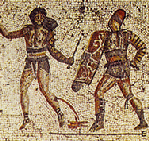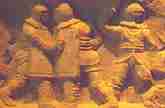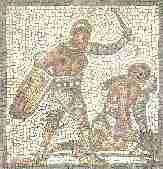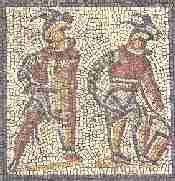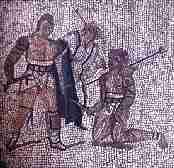| Gladiators | ||
| Home
Hoplomorchus http://depthome.brooklyn.cuny.edu/ classics/gladiatr/hoplmchs.htm A Mirmillogladiator attacking a Retiarius gladiator http://www.baselland.ch/docs/kultur/ augustaraurica/glossar/g/gladiatoren. htm From left to right: Mirmillo and Thracian Gladiators http://www.baselland.ch/docs/ kultur/augustaraurica/glossar/ g/gladiatoren.htm The Secutor gladiator is victorious http://search.britannica.com/frm_redir.jsp? query=gladiator&redir= http://www.vroma.org/%7 Ebmcmanus/arena.html |
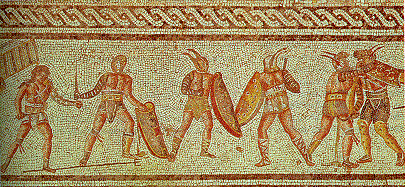 http://campus.northpark.edu/history//WebChron/Mediterranean/Gladiators.html Gladiatorial
games were of great importance in the time of the Roman Empire. The
gladiators began as a tribute to those that passed on to another life.
The games then were put on by upper class citizens to please the
common person and for entertainment purposes. The majority of those that
were gladiators were forced to be, while others were gladiators because
they volunteered to be.
There were schools that helped to train the gladiators and to
arrange them in their type for combat.
Like all attractions for entertainment the gladiatorial games
eventually came to an end. The
first known gladiatorial combat to take place was in Rome.
The game took place at the funeral of a nobleman, Junius Brutus
in 246 B.C. This started the trend to have gladiators fight at the
funerals of people of high status.
Eventually the news of gladiators at funerals began to catch the
attention of many people. Soon the occasions for the gladiators were in
more demand. Julius
Caesar took full advantage of how popular the games were becoming in
Rome. By the time the games reached Caesar; however, they had lost all
religious and funeral meanings. In turn the term gladiator (swordsmen)
came about. Caesar eventually brought all games under his control in 22
B.C. making it a state monopoly. From there the gladiators would go to
gladiator schools were they would be trained to fight in the arenas. The
gladiators were not interested in putting on a show for the Romans. It
took force, money, sophisticated training techniques and understanding
of the human mind to train the gladiators. The wealthy people would buy
the men, have them trained and then arrange combats for them to fight
against an opponent.
The
first school was in Campania, which was 100 miles from Rome. Eventually
more schools began to emerge. There were four large schools built near
Rome. The schools names were... the Great School (Ludus Magnus), the
Gallic School (Ludus Gallicus), the Dacian School (Ludus Dacius) and the
animal fights school ( Ludas Matutinus).
These schools were prison camps and training centers.
The whole purpose was to train the gladiator for combat in the
arenas. Once
a gladiator was admitted into a school he had to pass a fitness test,
and found out what was expected of him when he took the Gladiator Oath.
"I undertake to be burnt by fire, to be bound in chains, to be
beaten by rods, and to die by the sword". The gladiators were
thought to have felt like part of a group once they would take the oath. After
mastering the basic skills the gladiators would then practice with real
weapons to prepare them for the experience they would face in the arena.
The fighters would range from first to fourth in rank. The living
quarters were assigned according to rank. High-ranking
gladiators were expected to be a leader among the group. They were also
to introduce the novices to the guild of gladiators.
The higher-ranking gladiators would also offer a sense of
belonging and loyalty to the men. The
schools would boost a person's morale and force belief that gladiators
were members of an elite force. Those that had no place to go, were
slaves or were criminals felt they were part of something and were
worthy of human things.
The schools also offered trained and loyal men to fight in the
arenas and face death without fear. The
gladiators were prisoners of war, criminals, slaves, volunteered men,
and women. The prisoners of war ended up in Rome's slave markets and
would be auctioned off. The biggest and strongest were bought for
gladiator schools. The criminals were convicted of murder, rubbery,
arson, or sacrilege. The criminals were sent to the domnatin in ludum
for training in combat for about three years. The slaves were put up to
be gladiators because their master was bored of them, they ran away or
they wanted to dispose of them. At the height of the Roman Empire more
than 1/2 of all the gladiators were gladiators of choice, by their own
free will. The women were considered unlovely. Women did manage to
succeed were man failed; they managed to offend Roman sensibilities
enough to be banned. There
were six main types of gladiators. The first Samnite, named after the
people form Samnium. They were heavy armored. They had varnished helmets
with high-decorated crests and feathers.
They carried large shields called scutum and a small sword called
a gladius.
The
second type was the Hoplomorchus that were also heavily armored.
Their weapons were similar to the Samnite. Do differences have
been confirmed. The
third type was called Thracian. These gladiators were lightly armored.
They carried a small shield called a parma and a sword called a sica.
The helmets had mythological beasts on it.
Leg guards were worn on both legs. These men fought against heavy
armored gladiators. The
fourth type was the Mirmillo. They were identified by the images of
fishes on their helmets. They fought with short swords and a large round
shield. They had unarmored legs. The
fifth type of gladiator was the Retiarius. They fought with a
three-pronged fishing spear (trident). They had a net and did not wear a
helmet; instead they wore a headband. His protection was a guard on his
left arm and leg with a large shoulder piece. The
sixth type of gladiator was the Secutor. The helmet worn was round and
had two small eyeholes.
The right arm was covered with protective leather or metal bands.
The right hand carried a sword or dagger, while the left hand held a
large shield. The left leg had a metal guard. The whole left side of
this gladiator was protected. There
were a few types of gladiators that did not fit into one of the six
types of gladiators. These were the Lacquearius who were trained to
catch his opponent with a rope lasso. A Dimachaerus was a gladiator who
fought with two swords. The Eques was a gladiator who fought horseback
with a round shield and lance. The
gladiator games eventually began to be done away with. With Christianity
spreading about more people abandoned their pagan beliefs for a preached
love and peace.
Honorius banned gladiatorial games after a Christian monk,
Telemachus, was torn from limb to limb. Honorius abolished all gladiator
combats because they were no longer seen in the same way to many people.
These pages were complied by the following students of the University of Akron: Matt Clore (Senior), Heather Graham (Sophomore) and Courtney Mullen (Junior)
|
